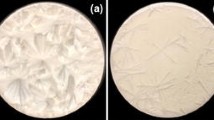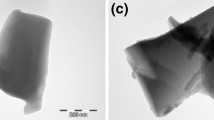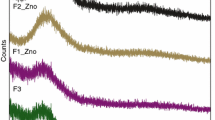Abstract
The results of synthesis of aventurine iron-containing low-melting glazes are given, their phase-formation mechanism is considered, and the optimum heat-treatment conditions are determined.
Similar content being viewed by others
REFERENCES
W. Wanie, “Kristalline glasuren und Kristallglasuren,” Glas-Email-Keramo-Techik., 16(11), 413-417 (1965).
W. Kersten, “Keramische glasuren-aufbau, farbgebund, gekortechniken und rohstoffe,” Sprechsaal., 122(4), 371-379 (1989).
Chen Xiangiu, Hand Ruifu, Sun Jund, et al., “Morphology of multiple liguid separation in iron oxide red glaze and chemical composition of various phases,” Chinese Ceram. Soc. 12(2), 236-242 (1984).
V. A. Perepelitsyn, Principles of Technical Mineralogy and Petrography [in Russian], Nedra, Moscow (1987).
A. A. Pimenova, “Synthesis of compositions and development of technological parameters in production of copper aventurine glasses for various purposes,” Auth. Abstr. Cand. [in Russian], Moscow (1984).
Author information
Authors and Affiliations
Rights and permissions
About this article
Cite this article
Levitskii, I.A. Mechanism of Phase Formation in Aventurine Glaze. Glass and Ceramics 58, 223–226 (2001). https://doi.org/10.1023/A:1012351301045
Issue Date:
DOI: https://doi.org/10.1023/A:1012351301045




